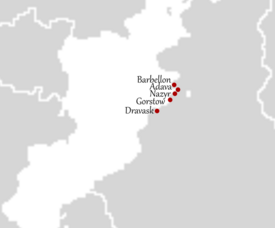Alban Pentapolis
Alban Pentapole Biela Piatemasta | |||||||
|---|---|---|---|---|---|---|---|
| 550–1304 | |||||||
 The five Alban cities | |||||||
| Capital | Dravask | ||||||
| Religion | Alban Christianity | ||||||
| Government | Federation | ||||||
| Historical era | Ikonkivoyra | ||||||
• Formation of the Federation | 550 | ||||||
• Integration to the Duchy of Nagytöva | 1304 | ||||||
| |||||||
The Alban Pentapolis was a federation of five city-states during the Drevstranese Middle Age united to resist potential invasions from their neighbors and to defend their common economical and political interests. It lay along the Lake Kupalnista, on the Nagytövan Coast, and limited to its east by the mountains of the Arädzo Highlands. The cities were extremely cosmopolitan with populations made up of various Slavic, Gothic, and Losh peoples but were united by their shared Alban faith, which gave its name to the federation.
Bastion of Alban Christianity, the Pentapolis remained independent for 650 years before becoming a Protectorate of the Duchy of Azdraï. It was the seat of the Apostolic Patriarchate of Barbellos (sometime written Barbellon) and an important collection of independent trading ports that ensured the connexion between what is modern-day Drevstran and the regions bordering the Kupalnista Lake. Part of its growth as a place of learning and theological teachings was due to the immigration of many Alban scholars from the rest of Belisaria, fleeing persecutions from other faiths.
Through the accords of Barbellon signed with the Lushyodorstag's royal family, the Gerzaïds, the Pentapolis remained a safe-haven for the Alban religion as these accords guaranteed the freedom of faith of the five cities, alongside other privileges. Even if, with time, communities of Orthodox and Docetic Christians would appear, Alban Christianity remain an important part of the cultural identity of these five ports who still exist to this day.